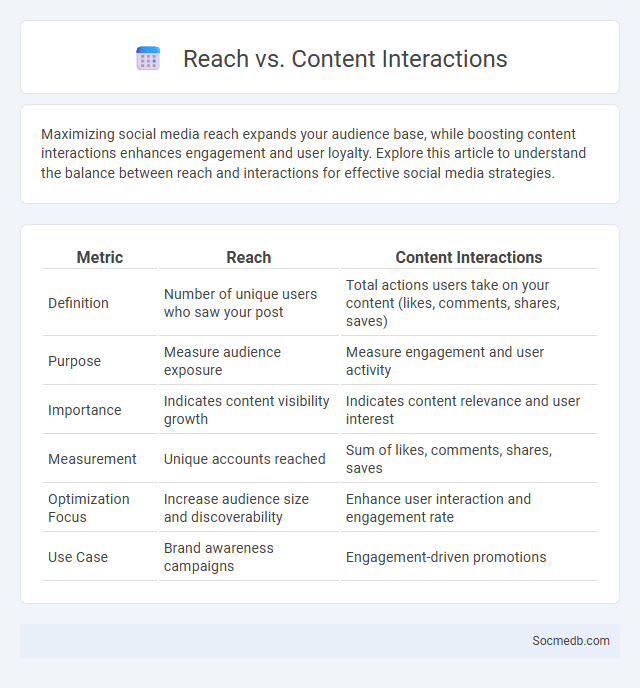
Photo illustration: Reach vs Content Interactions
Maximizing social media reach expands your audience base, while boosting content interactions enhances engagement and user loyalty. Explore this article to understand the balance between reach and interactions for effective social media strategies.
Table of Comparison
| Metric | Reach | Content Interactions |
|---|---|---|
| Definition | Number of unique users who saw your post | Total actions users take on your content (likes, comments, shares, saves) |
| Purpose | Measure audience exposure | Measure engagement and user activity |
| Importance | Indicates content visibility growth | Indicates content relevance and user interest |
| Measurement | Unique accounts reached | Sum of likes, comments, shares, saves |
| Optimization Focus | Increase audience size and discoverability | Enhance user interaction and engagement rate |
| Use Case | Brand awareness campaigns | Engagement-driven promotions |
Understanding Reach: Definition and Importance
Reach in social media refers to the total number of unique users who see Your content, indicating the breadth of Your audience exposure. Understanding reach helps you measure the effectiveness of marketing campaigns, optimize content strategy, and increase brand awareness. Tracking reach data enables accurate assessment of organic versus paid posts, guiding better resource allocation for maximum engagement.
What Are Content Interactions?
Content interactions on social media refer to the various ways users engage with posts, including likes, comments, shares, and reactions. These interactions signal content relevance and boost visibility within your network and algorithm feeds. Understanding how your audience interacts with content helps optimize your social media strategy for increased engagement and growth.
The Relationship Between Reach and Content Interactions
Maximizing your social media reach significantly influences the volume of content interactions, as a larger audience increases the potential for likes, comments, and shares. Creating engaging content tailored to your target demographic improves interaction rates, which in turn boosts algorithmic favorability and further extends reach. Your strategic focus on both expanding reach and enhancing content quality creates a synergistic effect, driving sustained growth and deeper audience engagement.
Key Metrics to Measure Reach
Key metrics to measure social media reach include impressions, which count how many times your content is displayed, and reach itself, indicating the number of unique users who saw your posts. Engagement rate also provides insight into how actively your audience interacts with your content through likes, comments, and shares. Monitoring follower growth helps track expanding audience size and overall visibility across platforms.
Evaluating Content Interactions: Types and Examples
Content interactions on social media encompass likes, comments, shares, and saves, each serving distinct purposes in user engagement. Likes indicate passive approval, comments foster conversations and community building, shares amplify content reach, and saves reflect content value for future reference. Analyzing these interactions helps brands measure audience interest, adapt strategies, and enhance overall social media performance.
How Reach Influences Content Interactions
Reach significantly impacts content interactions by expanding the potential audience exposed to posts on platforms like Facebook, Instagram, and Twitter. Higher reach increases the likelihood of likes, comments, shares, and overall engagement metrics, as more users have the opportunity to interact with the content. Algorithms on social media sites often prioritize content with greater reach, amplifying visibility and fostering greater user interaction.
Increasing Reach vs Boosting Interactions: Strategies Compared
Increasing reach on social media involves targeting broader audiences through content optimization, hashtags, and paid promotions to maximize visibility. Boosting interactions focuses on engaging your existing followers with compelling calls-to-action, interactive posts, and timely responses to comments. Understanding these strategies will help you tailor your approach to either grow your audience or deepen connections with your current community.
Analyzing Data: Correlating Reach with Engagement
Analyzing data by correlating reach with engagement reveals valuable insights into how your social media content performs. Higher reach often indicates greater brand visibility, while increased engagement reflects audience interaction and interest. By examining these metrics together, you can optimize your strategy to enhance both exposure and user participation effectively.
Common Misconceptions: Reach vs Content Interactions
Many people confuse social media reach with content interactions, assuming that a higher reach automatically means better engagement. Reach refers to the total number of unique users who see your content, while interactions include likes, comments, shares, and clicks that demonstrate active engagement. Understanding this difference helps you tailor your strategies to boost meaningful conversations rather than just increasing visibility.
Optimizing Social Media Strategies for Maximum Reach and Engagement
Optimizing social media strategies involves analyzing platform algorithms, audience behavior, and content performance to maximize reach and engagement. Leveraging targeted hashtags, optimal posting times, and multimedia content enhances visibility and drives higher interaction rates. You can boost brand presence and foster community growth by consistently refining your social media approach based on data-driven insights.
 socmedb.com
socmedb.com